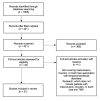Relationship Between Occlusal Factors and Temporomandibular Disorders: A Systematic Literature Review
- PMID: 38487145
- PMCID: PMC10939299
- DOI: 10.7759/cureus.54130
Relationship Between Occlusal Factors and Temporomandibular Disorders: A Systematic Literature Review
Abstract
Temporomandibular disorders (TMD) originate from various components within the temporomandibular joint (TMJ), causing an impact on the masticatory muscles, the joint itself, and associated structures. They are a widely prevalent issue across the world. According to epidemiological research, up to 50% of adults in the population have TMD-related symptoms. The objective of this work was to analyze the existing scientific literature regarding the association between malocclusion classes, bruxism, and tooth loss in relation to the etiology of TMD. This systematic review was conducted following the Preferred Reporting Items for Systematic Reviews and Meta-Analyses (PRISMA) 2020 analysis protocol. For the development of the question focus, the population, intervention, control, and outcomes (PICO) study design protocol was used. The question in focus according to the PICO format was: "Do malocclusion, tooth loss, and bruxism contribute to temporomandibular disorders?". The review was performed with articles from PubMed, Web of Science, and Google Scholar databases according to the specified inclusion and exclusion criteria. The included articles were not older than five years. The risk of bias was assessed in the included studies by using the Cochrane Risk-of-bias 2 (RoB-2) tool. Out of a total of 32 results received, 21 articles were chosen according to the established criteria after conducting a review and analysis of their full texts. The article search sequence was presented in the PRISMA 2020 flow diagram, and the outcomes of the chosen articles were presented. The literature results revealed a relationship between occlusion and the development of TMD. The influence of occlusal factors on the TMJ was explained by an examination of joint anatomy and symptoms related to TMD. This study revealed variations in TMJ factors across different malocclusion classes. Additionally, it was observed that the occurrence and attributes of TMD are influenced by the number of tooth loss quadrants and the frequency of missing teeth. Furthermore, a correlation was found between bruxism and the symptoms of TMD, including myofascial pain, disc displacement, arthralgia, and muscle disorders. This literature review provides comprehensive information on the relationship between malocclusion classes, bruxism, tooth loss, and TMDs. This prompts healthcare professionals to prioritize patients' occlusal assessment and TMJ condition.
Keywords: bruxism; malocclusion; temporomandibular disorders; temporomandibular joint (tmj) disorders; tmd; tmj; tooth loss.
Copyright © 2024, Lekaviciute et al.
Conflict of interest statement
The authors have declared that no competing interests exist.
Figures



Similar articles
-
The association between wear facets, bruxism, and severity of facial pain in patients with temporomandibular disorders.J Prosthet Dent. 2003 Aug;90(2):194-200. doi: 10.1016/s0022-3913(03)00332-9. J Prosthet Dent. 2003. PMID: 12886214
-
The effectiveness of manual therapy applied to craniomandibular structures in the treatment of temporomandibular disorders: protocol for a systematic review.Syst Rev. 2021 Mar 8;10(1):70. doi: 10.1186/s13643-021-01623-7. Syst Rev. 2021. PMID: 33685496 Free PMC article.
-
Association between chewing dysfunctions and temporomandibular disorders: A systematic review.J Oral Rehabil. 2018 Oct;45(10):819-835. doi: 10.1111/joor.12681. Epub 2018 Jul 4. J Oral Rehabil. 2018. PMID: 29908034
-
Occlusion and Temporomandibular Disorders: A Scoping Review.Medicina (Kaunas). 2025 Apr 24;61(5):791. doi: 10.3390/medicina61050791. Medicina (Kaunas). 2025. PMID: 40428749 Free PMC article.
-
Morphological and positional assessments of TMJ components and lateral pterygoid muscle in relation to symptoms and occlusion of patients with temporomandibular disorders.J Oral Rehabil. 2000 Oct;27(10):860-74. doi: 10.1046/j.1365-2842.2000.00622.x. J Oral Rehabil. 2000. PMID: 11065021
Cited by
-
Assessing, categorizing and proposing the therapeutic effect of complete dentures on temporomandibular disorders analyzed by craniomandibular index: a prospective interventional study.BMC Oral Health. 2025 Apr 16;25(1):580. doi: 10.1186/s12903-025-05979-3. BMC Oral Health. 2025. PMID: 40241104 Free PMC article.
-
The impact of malocclusion on the prevalence of pain-related temporomandibular disorders in children and adolescents: a systematic review.Front Neurol. 2025 Apr 3;16:1550110. doi: 10.3389/fneur.2025.1550110. eCollection 2025. Front Neurol. 2025. PMID: 40248012 Free PMC article.
-
Guided Endodontics for a Tooth with Root Fracture: A Case Report.J Clin Med. 2025 Jun 9;14(12):4079. doi: 10.3390/jcm14124079. J Clin Med. 2025. PMID: 40565825 Free PMC article.
-
Structural Features of the Temporomandibular Joint Evaluated by MRI and Their Association with Oral Function and Craniofacial Morphology in Female Patients with Malocclusion: A Cross-Sectional Study.J Clin Med. 2025 Jul 11;14(14):4921. doi: 10.3390/jcm14144921. J Clin Med. 2025. PMID: 40725615 Free PMC article.
-
Temporomandibular disorder prevalence in malocclusion patients: a meta-analysis.Head Face Med. 2025 Feb 26;21(1):13. doi: 10.1186/s13005-025-00490-0. Head Face Med. 2025. PMID: 40011997 Free PMC article.
References
-
- Relationship between natural or iatrogenic malocclusions and temporomandibular disorders: a case control study. Mélou C, Leroux L, Bonnesoeur M, Le Padellec C, Bertaud V, Chauvel-Lebret D. Cranio. 2024;42:206–214. - PubMed
-
- Occlusion, orthodontics, and temporomandibular disorders: cutting edge of the current evidence. Michelotti A, Rongo R, D'Antò V, Bucci R. J World Fed Orthod. 2020;9:0–8. - PubMed
Publication types
LinkOut - more resources
Full Text Sources
